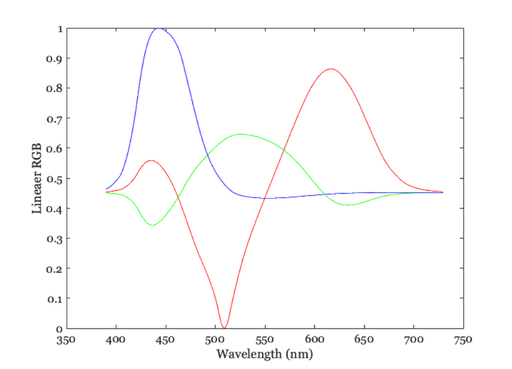Use color principles to create a spectrum (Psych 221)
Use the principles of color matching to render an approximation to the visible spectrum on a display.
Class: Psych 221/EE 362 Tutorial: Spectrum Author: Wandell Purpose: An example calculation: making a desaturated rainbow. Date: 01.12.98 Duration: 20 minutes
PURPOSE: This tutorial uses the color-matching tools to create an image approaching the appearance the rainbow (the spectral colors) on your display.
Contents
- Load the color matching functions
- Model a display
- Compute the conversion matrix
- Compute the RGB values of spectral lights now
- There is one adjustment I would like to make to the spectral colors.
- Here is a graph of the R,G and B values for each wavelength.
- Out of gamut colors
- Convert for the nonlinear DAC values
- Show the image
- Here is a plot of the DAC values we ended up with.
ieInit
Load the color matching functions
% These are are essential for creating calibrated signals. So, we load % them first. wavelength = 390:730; XYZ = ieReadSpectra('XYZ.mat',wavelength);
Model a display
% Let's suppose the spectral power distributions of your monitor's % phosphors are from the LCD-APple. d = displayCreate('LCD-Apple','wave',wavelength); phosphors = displayGet(d,'spd'); % Here is a plot of the phosphors vcNewGraphWin; plot(wavelength,phosphors(:,1),'r', ... wavelength,phosphors(:,2),'g', ... wavelength,phosphors(:,3),'b') xlabel('Wavelength(nm)'); ylabel('Energy (watts/st/m^2/nm'); set(gca,'xlim',[350 750]); xlabel('Wavelength (nm)'); ylabel('Lineaer RGB');
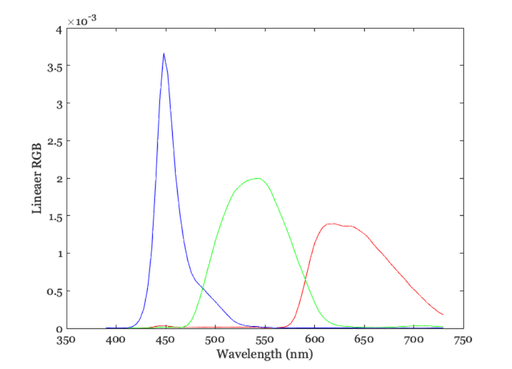
Compute the conversion matrix
% This matrix converts between XYZ values and linear intensities of the % monitor RGB values. % We do this in two steps. First, we find the XYZ values for each of the % individual phosphors. The columns of this matrix represent the XYZ % values of the red, green and blue phosphors, respectively. These values % should be relatively easy to interpret. % rgb2xyz = XYZ'*phosphors % Invert the rgb2xyz matrix so that we can compute from % XYZ back to linear RGB values. % xyz2rgb = inv(rgb2xyz) % Notice that the values of the xyz2rgb matrix contain negative % values and are difficult to interpret directly. Such is life.
rgb2xyz =
0.0673 0.0622 0.0297
0.0345 0.1287 0.0097
0.0017 0.0146 0.1608
xyz2rgb =
19.6282 -9.1298 -3.0667
-5.2759 10.2748 0.3502
0.2671 -0.8321 6.2202
Compute the RGB values of spectral lights now
% Remember that the XYZ values of each spectral light is contained in the % rows of the XYZ matrix. So, we need only to multiply the two matrices as % in: rgbSpectrum = xyz2rgb*XYZ'; % This calculation would produce the rgbSpectrum for monochrome lights of % equal energy. But, equal energy monochrome lights do not appear equally % bright. The brightest part of the spectrum is near 550nm, and the blue % and red ends are much dimmer (per unit watt). %
There is one adjustment I would like to make to the spectral colors.
% I would like to display spectral colors that are imilar in their % brightness. To adjust the overall luminance of the spectral values, I % will scale the XYZ values of each spectral light by a function that is % related to the Y value. Remember that the Y value is correlated with % brightness. So, if we scale by the Y value, we can compensate a bit for % brightness differences. % Here is what I propose to use as a scale factor. Yvalue = XYZ(:,2); scaleFactor = (Yvalue + 0.4); % Now, let's scale the rgb values. Pay attention to the fact that I am % doing this scaling in the linear RGB space. This calculation would be % wrong if I did it on the frame buffer values, rather than the linear RGB % intensities. rgbSpectrum = rgbSpectrum*diag( 1 ./ scaleFactor); rgbSpectrum = rgbSpectrum'; % Here is a plot of the scale factors I used to make the % brightness of the wavelengths more nearly equal. vcNewGraphWin; plot(wavelength,1./scaleFactor,'k') set(gca,'ylim',[0 2]), grid on

Here is a graph of the R,G and B values for each wavelength.
% The horizontal axis shows wavelength and the three colored curves show % the linear intensity values needed for the phoshors. vcNewGraphWin; plot(wavelength,rgbSpectrum(:,1),'r', ... wavelength,rgbSpectrum(:,2),'g', ... wavelength,rgbSpectrum(:,3),'b') grid on set(gca,'xlim',[350 750]); xlabel('Wavelength (nm)'); ylabel('Lineaer RGB');
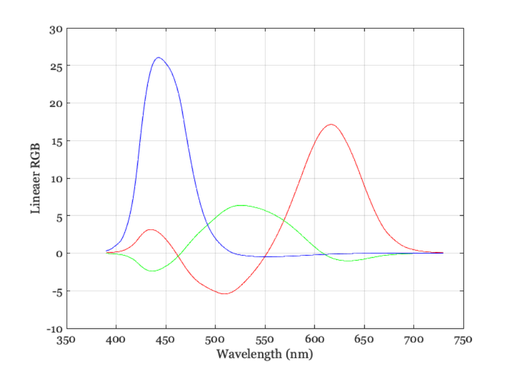
Out of gamut colors
% Some of the RGB values are negative. These are called "out of gamut" and % cannot be displayed precisely. There is no getting around this problem % either for this example or in many real world applications. Some physical % colors in the world simply cannot be displayed on conventional monitors, % with three primaries. This corresponds to the observation that in the % color-matching experiment sometimes we must move one of the primaries to % the other side of the field. % There are many different suggestions (hacks) that people use to overcome % the basic physical limitation of displays. For our purposes, we can use % a fairly simple compromise -- some of you may like it, others may not. % That is the nature of this business. % We can display these rgb values superimposed on a constant gray % background. By superimposing the spectrum on a constant background, we % can both add and subtract RGB values. % I propose that we use a gray background that is only as bright % as the most negative rgbSpectrum value. grayLevel = abs(min(rgbSpectrum(:))) rgbSpectrum = (rgbSpectrum + grayLevel); % And, we scale the RGB values in rgbSpectrum so they are as large as % possible, but the sum of the background and these values will still be % less than the maximum display value (1). rgbSpectrum = rgbSpectrum/max(rgbSpectrum(:)); vcNewGraphWin; plot(wavelength,rgbSpectrum), grid on set(gca,'xlim',[350 750]); xlabel('Wavelength (nm)'); ylabel('Lineaer RGB'); % Now, we correct for the display nonlinearities by presuming that we know % something (which we don't) about your display. Here is the display gamma % function relating a standard monitor frame buffer entries to the display % intensities. % load cMatch/hit489Gam
grayLevel =
5.4240
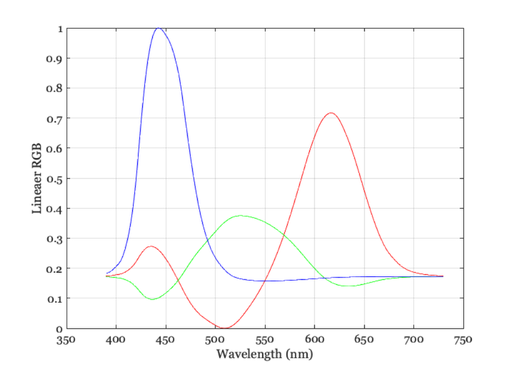
Convert for the nonlinear DAC values
% Here is the function we use to convert the linear values in rgb to the % frame buffer (DAC) values. gTable = displayGet(d,'gtable'); DAC = lrgb2srgb(rgbSpectrum); % To display the image, we sample every other wavelength value. I am % worried about running out of color map entries! waveSamp = 1:2:size(DAC,1); mp = DAC(waveSamp,:); wavelength = wavelength(waveSamp);
Show the image
% Create a linear ramp to show the color map values. im = 1:size(mp,1); % and show 'em % vcNewGraphWin; mp = mp/max(mp(:)); colormap(mp);image(wavelength,1,im) xlabel('wavelength (nm)') % Notice that the color start to fade towards the end. Why do % you think that is? Try varying some of the choices I made, % such as the scaleFactor and the intensity of the gray % background.
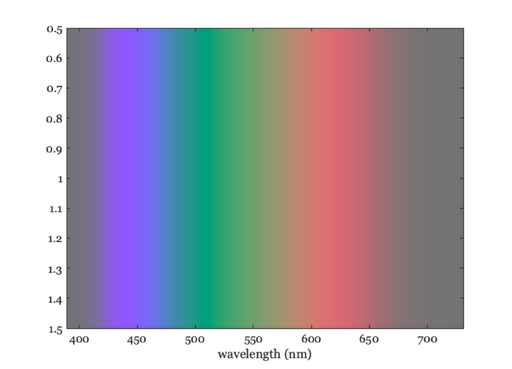
Here is a plot of the DAC values we ended up with.
vcNewGraphWin; plot(wavelength, DAC(waveSamp,1),'-r',... wavelength, DAC(waveSamp,2),'-g',... wavelength,DAC(waveSamp,3),'-b') set(gca,'xlim',[350 750]); xlabel('Wavelength (nm)'); ylabel('Lineaer RGB'); % Notice that the overall saturation is quite limited by one part % of the spectrum. Perhaps if we didn't try to reproduce just % that part of the image, or we adjusted just that part, we could % obtain a more saturated overall appearance. Again, a design % decision.
